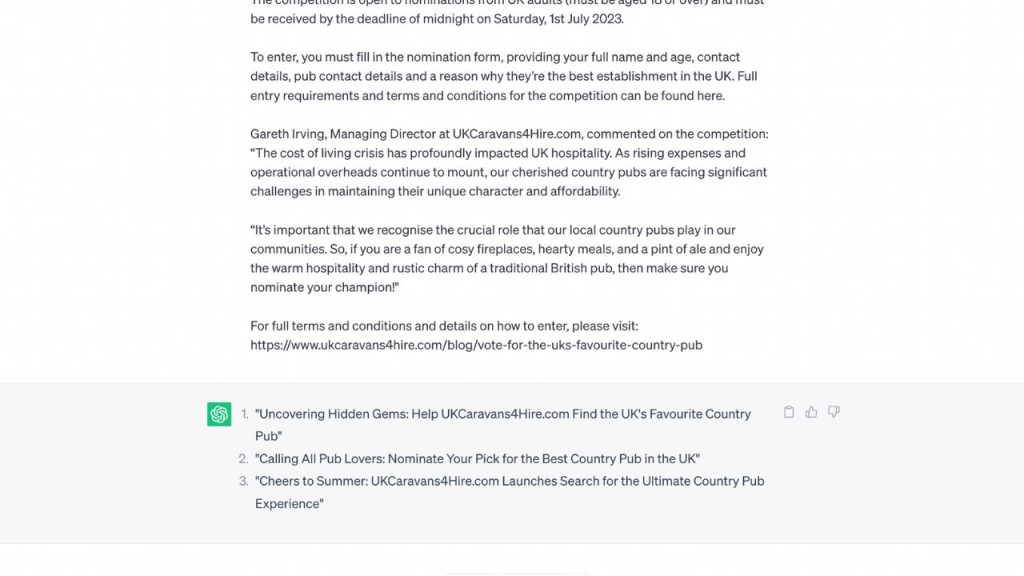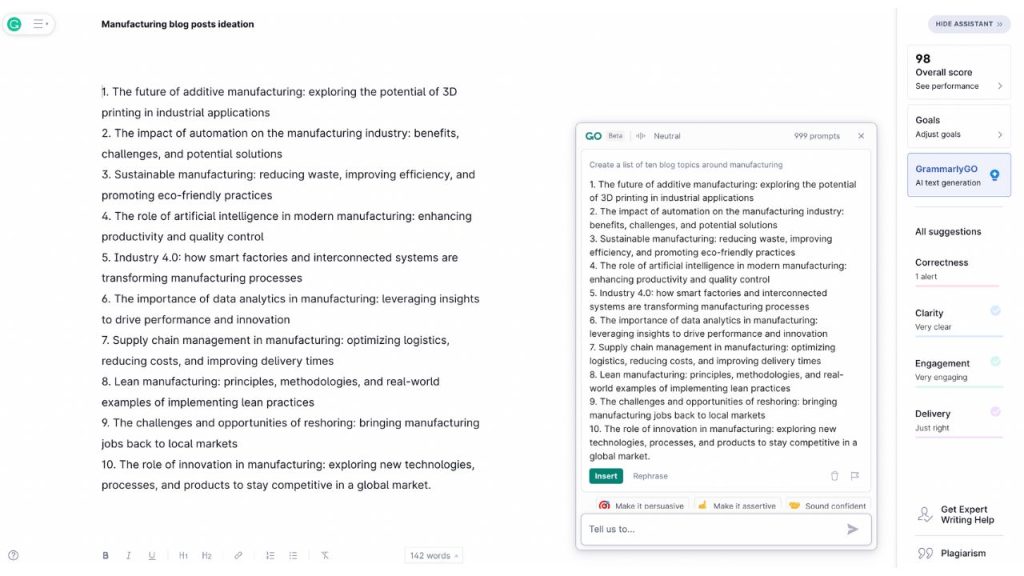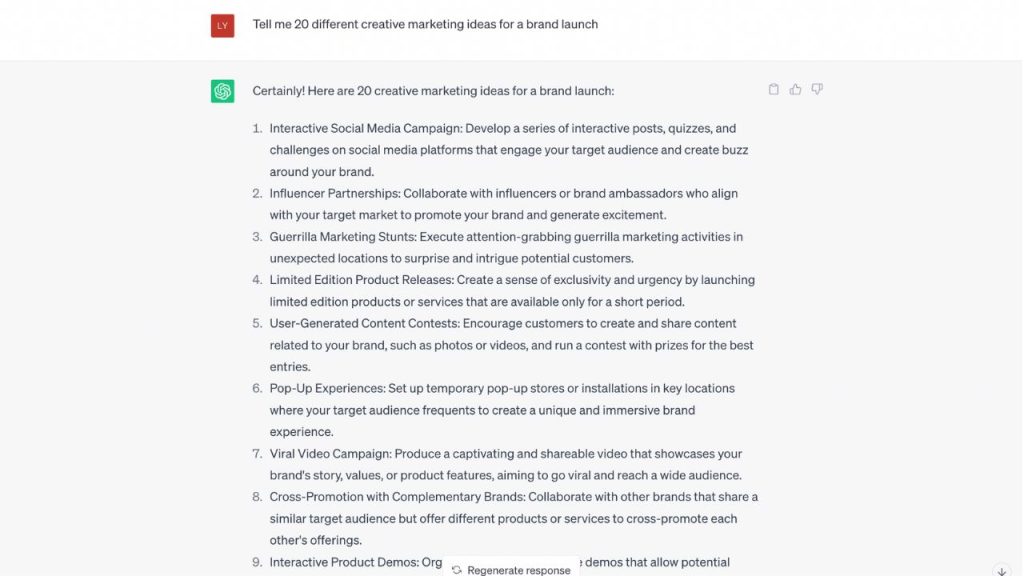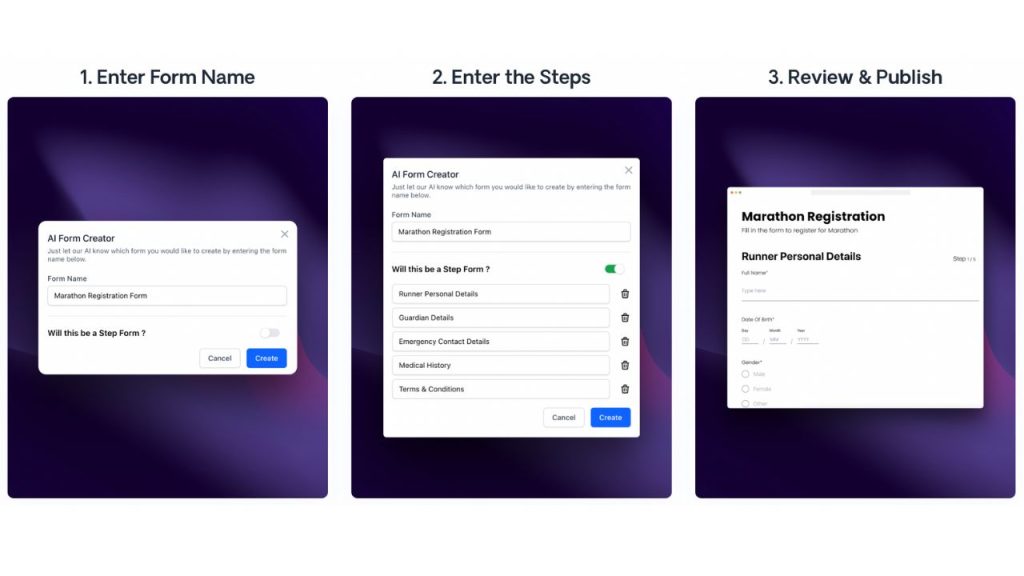Discussions around Artificial Intelligence (AI) are trending right now, with a 611% increase in online interest for the term ‘AI’¹ and a 126% increase for the search term ‘AI marketing’² over the last 12 months.
There is huge potential for AI to support the PR and marketing industry by improving productivity and allowing more time to plan and research for campaigns effectively. However, recent studies show that Brits feel hesitant about the implications of AI within the workplace, with 64% of Brits believing the number of jobs lost to AI automation will be higher than the number created.
To help lessen those worries, we have gathered the ultimate guide to AI within the PR and marketing world, along with some key tools to test out at the end!
Read on to be inspired on ways to increase your efficiency and unlock creative ideas:
-
1. Create engaging headlines with AI
Traditional and digital PR is a great way to increase brand visibility and awareness, aswell as improve online visibility. But you need to secure the coverage first. One of the best ways to ensure that your press release grabs the attention of your desired audience is to use a catchy headline.
AI can help you to brainstorm creative ideas for the article to intrigue the reader. For instance, you could input this request into Chat GTP; ‘Write three different creative headlines for the below article (copy in your press release)’. Here are some examples we had for a recent press release centred around a new competition to find the UK’s favourite country pub for our client UKCaravans4Hire.com:

Another free platform for headline generation is Copylime which asks you to input your article subject, along with a preferred tone, and will give you multiple headline suggestions in seconds.
The AI add-on GTP workspace for Google Sheets can also suggest rewords of any text into a specific tone of voice. Need a fun headline for a lifestyle publication? No problem, ask for ‘make this fun’ and then tweak it to ensure it matches the aim of your article.
-
2. Using AI to help with media list creation
You can quickly collect a list of target publications for a media list by asking the platform such as Chat GTP or GPT-3 Playground, ‘Collate me a list of the ten most popular manufacturing publications’. This cuts out time manually searching the internet to create a list of publications in your niche and allows you to spend more time researching journalists from each publication.
While it combining a range of sources for your media list is essential, for example, searching Twitter for relevant editors within a sector and using journalist contact databases like Vuelio to find contact details for writers who have covered similar topics, AI is excellent for initial research.
-
3. Analyse PR data with AI tools
Data-led PR campaigns are often the most compelling in journalists’ minds as they contain brand-new data that they wouldn’t necessarily have the budget or resources to obtain themselves, such as nationally representative surveys or search data for specific keywords. However, the data can take hours to methodically analyse into readable data ready to be input into your press release, so using AI tools can speed up this process.
For example, GTP for Google Sheets can help to organise and classify your customer data to find trends.
-
4. Using AI for blog idea generation
Blogs are a great way to boost your website’s online visibility by improving keyword positioning and domain authority, increasing the chances of your business appearing on the first page of search engines. As a regularly updated blog is essential for this, you can use AI to help with brainstorming sessions, quickly giving ideas to further fill out with expert insight from your sector.
Text-based AI platforms, such as Chat GTP or GrammarlyGO, are a great way to quickly gather board ideas around a topic from your query. For instance, you could ask, ‘Create a list of ten blog topics around manufacturing.’ This will provide you with a rough content plan to fill out with SEO-optimised content for your website users and potential customers to engage with.

GrammarlyGo also works directly within compatible workload management systems, such as Productive.io, to allow for collaborative brainstorming for teams within a campaign or client project.
If you have a more technical or complex blog topic, you can use platforms such as Explain Like I’m Five to gain a simple understanding as a jumping-off point.
-
5. Summarise your written work with AI
Another valuable feature of AI tools is their ability to break down your on-site content and press releases into its most basic, vital points. You can ask tools, such as ChatGTP or Article Summarizer, to provide a quick overview of the main takeaways of your article to show you if any key messages are absent or need to be expanded upon.
You can also use these summaries to assist with writing a concise, professional journalist pitch which you can personalise to each journalist’s interests to increase the chance of it landing. For example, referring to a recent article they have written that your story could support further.
If you wish to turn a blog post, press release, or a longer post from another platform into a Tweet, you can use summarising tools such as Blog Tweet to generate a concise overview specifically created for a Twitter post.
-
6. Use AI-powered sentiment analysis
Once you have created your PR content, you can use AI platforms to quickly analyse the sentiment for a quick overview of how your audience could perceive your brand’s message.
Platforms such as Honesty Meter will tell you how biased an article is, with the aim to increase honesty and transparency in your media content as well as many PR and communications software used for journalist databases and press coverage monitoring like Vuelio.
Use this information to help inspire the writing of your own types of PR, for example, a more formal business appointment release sent out to local publications versus a national PR campaign to increase brand awareness.
-
7. Gain inspiration for social media captions
When creating social media content, one of the most time-consuming tasks is adapting your captions to the requirements of each platform, such as Twitter’s word count limitations. You could use Chat GTP, “Adapt this LinkedIn caption to suit a Twitter post with up to 280 characters, including spaces.”
Another useful free tool is Caption Gen which generates creative social media captions using your key messages and your chosen desired caption style (including; funny, creative, informative, quirky or robotic!).
Some paid social media scheduling tools, such as Sked, Later and Sendible also have built-in AI tools to help you create creative and engaging content without leaving your content calendar.
-
8. Using AI to support overall marketing strategy
A clear long-term PR and marketing strategy will help team members to stay on track with deadlines and achieve fantastic results. However, it can sometimes be time-consuming to brainstorm and research potential ideas at the first stage of strategy development.
So, you could ask Chat GTP, ‘Tell me 20 different creative marketing ideas for a brand launch,’ which would give you a jumping-off point to create a killer PR and marketing plan to suit your business or client.

You can get free AI-powered advice on potential marketing and business ideas on platforms such as VenturusAI, which will give you pointers for how to make it successful.
-
9. Using AI to create internal and external marketing briefs
Any great PR or marketing idea starts from a creative brief, listing your objectives, methodology, research and more to ensure you have permission from key stakeholders to run the campaign.
Tools such as Briefly use AI-insights to generate an informative and professional brief quickly and give hints on how to improve each section of the document. You could also ask Chat GTP, “Create a marketing brief layout”, and then fill in and expand the sections with your own information.
-
10. Create AI-powered data collection forms
Online forms are a cost-effective way to collect data to support your PR and marketing campaigns. They can be shared across various platforms, including email, social media and your website.
Your data can be collated into a newsworthy, unique ranking in your press release, increasing the chance of the story being covered.
Online forms can also collect useful customer data, such as buying preferences and customer satisfaction rates, to help e-commerce businesses understand their customer behaviours and improve the customer journey online.
AI-powered form creation tools, such as Make Forms, take the information inputted and automatically create email-based forms based on your needs.

Top free AI platforms for PR and marketing professionals:
Chat GTP – Perfect for any type of text-based enquiry
GTP for Google Sheets and Docs – For easy support with your text or data directly in the document
Caption Gen – Create engaging social media captions
Make Forms – AI-generated forms (free trial available)
Honesty Meter – Easily track the bias within your written content
VenturusAI – AI-powered business advice (free starter plan available)
Explain Like I’m Five – Gain a simple explanation for any topic
Blog Tweet – Turns any blog into a Twitter post
GrammarlyGO – Useful for text-based enquiries and brainstorming
We highly recommend keeping an eye on the Future Tools website to stay updated with new tools to support your specific business sector and business need.
How Wild PR can help
If you are looking for creative, Wild SEO-driven ideas to boost your online rankings, increase brand awareness and encourage website conversions, Wild PR can help.
Check out our recent client campaigns, aswell as our case studies, to see how we have applied our creative skillset to help a wide range of businesses.
Get in touch with our talented team today to discuss your next showstopping marketing or PR campaign!
Sources:
- Google trends data for the search term ‘ai’ from June 2022 to June 2023.
- Google trends data for the search term ‘ai marketing’ from June 2022 to June 2023.